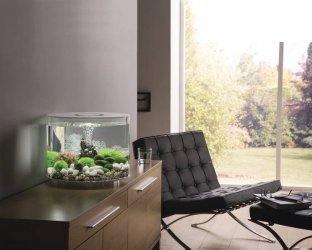Adjusting pH will not be successful except in connection with lowering the GH and KH. The three are closely related.
The chemicals like "pH down" not only will not work long-term, they will cause immediate pH fluctuations that can be severe; pH affects fish but if it is stable the fish are better able to manage (within reason) whereas rapid fluctuations could kill them outright.
Part of the reason is the KH (Alkalinity). This carbonate hardness works to "buffer" pH, preventing it from fluctuating. So as an example, if you add pH Down and the pH within say an hour lowers from 8.0 to 7.0, the buffering capability due to the GH and primarily KH then kicks in and the pH goes back up to 8.0 over the next few hours. This back and forth is what seriously harms fish.
So reducing the GH and KH, as by adding "pure" water such as RO, distilled or sometimes rainwater, is the only safe method. Mixing RO and tap water will result in a proportional change. For example, half tap water and half RO will reduce the tap water GH and KH by half. So if the GH of the tap water is 15.82, say 16 dGH, half/half will result in 8 dGH water, with a similar reduction in the KH. The ph might lower some just from this, you will have to test it.
The above is as simple as I can put it, but there are other factors involved, or may be. I've never had to go down this road, thankfully, though I have had the opposite issue of having to increase GH/pH for certain fish over the years. That is much easier, in my view.
If you do decide on this approach, remember that water changes will be more work. The water will have to be adjusted outside the tank. Fortunately, with a 10g tank you are not dealing with enormous volumes of water, and a 50% water change is not as onerous as it would be for me with several tanks and large ones too. Emergency water changes may occur though, which means having a good supply of RO water on hand.
To your question about cardinal tetras in a 10g...what exactly is a "tube" tank? Did you mean "cube?" The shape is not that critical here (though the surface area of the water is important), as cardinals are not active swimming fish, so we can deal more directly with the volume. You want as many as you can manage, since this is a tight shoaling species; I wold not go below 7, and up to 9-10, though the tank dimensions might alter this once I know it. Live plants will help, even if just floating; and floating plants are important as cardinals do not appreciate overhead light, they have what some ichthyologists term a light phobia.
Byron.


